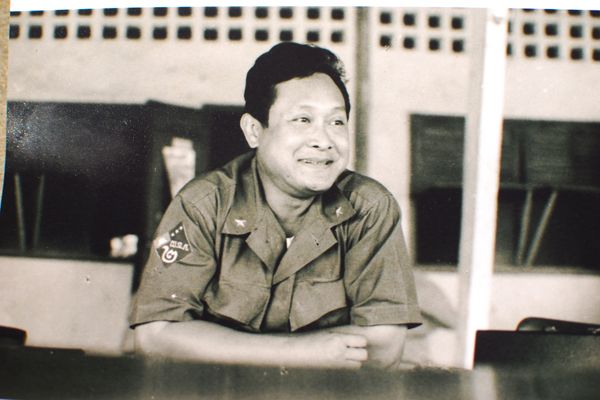
- Prince Chantaraingey at Doh Kanchor, the former military base in Kampong Speu province, in early 1975. (Photo: Courtesy Spencer Dale)
"Chantaraingsey – a Norodom battling his cousin, Sihanouk – embodied the familial nature of the civil war, which eventually consumed most of the princes and revolutionaries that made up its cast. [Saloth Chhay, Pol Pot’s elder brother, at that time served as an orderly to Chantaraingsey, further confusing the war’s tangled web of familial relations]"MINH Chin last spoke to her husband 35 years ago, over a crackly phone line. She was in Phnom Penh, on the eve of the city’s fall to the Khmer Rouge, and he was on the outskirts, preparing for his last stand against the communists.
“He called me to say that our regime was lost and that we would meet
again after the country got peace, and he told me to do everything the
Khmer Rouge soldiers ordered me to do,” she recalled. The line then went
dead, and after more than 25 years of marriage, that was the last she
heard or saw of him. “I don’t know how he died, where he died, or when
he died,” she said, wiping away a tear.
Minh Chin, a sprightly but frail woman of 77, says she often hears
rumours her husband is alive and well, living a quiet life in some other
part of the country. After travelling to Phnom Penh in several
fruitless attempts to track him down, she found only strangers,
misidentified or using his name and title for personal gain. They were
“fake people” who impersonated him, she said: village conmen and
rumourmongers who still manage to captivate local populations by
conjuring up the name of Prince Norodom Chantaraingsey.
A largely forgotten figure in the West, Chantaraingsey still retains a
potent mystique in rural Cambodia. A keen advocate for Cambodian
independence, the prince was one of the few royals to throw in their lot
with Lon Nol’s Khmer Republic, which abolished the monarchy in October
1970 and ran the country until 1975. After Chantaraingsey’s cousin,
then-Prince Norodom Sihanouk, was overthrown in March 1970, he took up
command of a military brigade in Kampong Speu.
From 1972 until the fall of Lon Nol, Chantaraingsey served as
brigadier general, presiding over a virtually autonomous fief. A gifted
commander, he was revered by the local peasantry and earned the praise
of foreign observers. Even after the Khmer Rouge takeover, when he was
presumed killed, Chantaraingsey remained one of the few hopes for
resistance.
At our interview, Minh Chin sat straight-backed, dressed in a navy
blue and white floral print dress. Under the sloping wooden ceiling of
Wat Chan Sok Vannaram, a leafy pagoda in her home village of Trapaing
Mon, she had a faintly regal air, though it was hard to tell if it was a
shadow of her privileged past, or simply her contrast with the rustic
surroundings. From a wooden beam above the table hung an old portrait of
Sihanouk from the 1960s, yellowing and warped by humidity.
As the former wife of a royal, Minh Chin said she visited Sihanouk
several times after he returned to the country and was crowned king in
1993. But her links to the palace – formalised only by marriage –
gradually wore thin, until the old connection started to remind her of
past pains. In 1994, she retired to the pagoda in Trapaing Mon, where
she has spent the past 15 years in the traditional Khmer fashion,
praying and cooking food for the resident monks.
The only remaining memento of her husband is a gilt-framed photo from
the early 1970s, hanging from a wooden column near the black-framed
portrait of Sihanouk. It shows Chantaraingsey – dressed in army
fatigues, red beret and sunglasses – standing on the wide stone rampart
in front of Angkor Wat.
“It is enough for me living at a pagoda,” she said. “I don’t miss
everything from the past, when I lived in the royal family, because I
want to forget it all.”
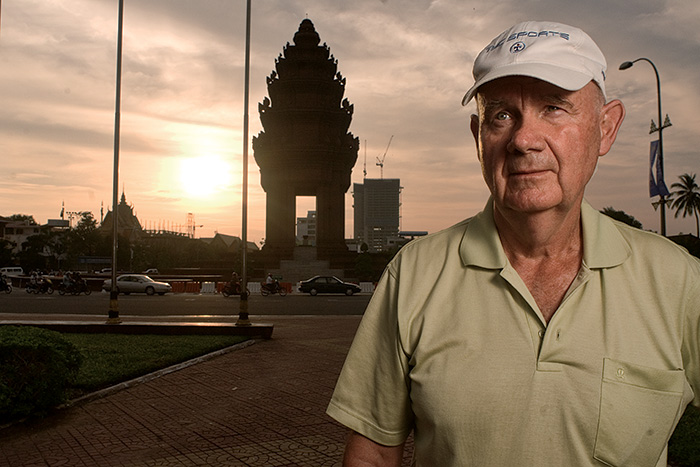
- Spencer Dale during his visit to Phnom Penh last month. (Photo: Rick Valenzuela)
THOUGH most sources agree Chantaraingsey was killed by the Khmer
Rouge some time after they seized power in April 1975, rumours of his
survival have persisted. The Bangkok Post reported that
Chantaraingsey was still active in June 1975, leading 2,000 men in a
guerrilla war against the communists. Belgian journalist Jacques Bekaert
wrote that his troops were still fighting on as late as 1977, when they
were thought responsible for the destruction of a refinery at Kampong
Som.
Youk Chhang, director of the Documentation Centre of Cambodia, said
Chantaraingsey’s royal lineage and local popularity combined to produce a
mythical aura. This was bolstered by rumours that Chantaraingsey’s men –
distinguished by their roaring tiger insignia and white scarves – were
immune to bullets.
Youk Chhang said Chantaraingsey and his troops were ascribed
responsibility for a string of unrelated incidents in Democratic
Kampuchea, including minor acts of theft and destruction that were
likely the work of jao prey – jungle people living beyond the reach of
the Khmer Rouge.
At some point around 1976, an airplane appeared over Siem Reap. Khmer
Rouge telegrams show that Chantaraingsey was thought to be behind the
mysterious craft. “Suddenly, the rumour was spread it was him,
Chantaraingsey, who was flying the plane,” Youk Chhang said. “He became
almost magical.”
Accounts of the prince’s death vary widely. The Historical Dictionary of Cambodia
claims he was killed while trying to save his wife in Battambang after
April 1975; another account, by Hass Savoeun, a member of the United
States-based Buddhist Khmer Centre, says he met his end when his troops
attempted to fight their way out of their besieged barracks in Kampong
Speu and escape to Thailand.
“There’s no hard evidence to prove that he died, but had he been
alive he would have returned” to Phnom Penh, said Youk Chhang. “In terms
of hard evidence of the Khmer Rouge at the time, no such thing exists.”
For Spencer Dale, an Australian adventurer who spent extended periods
in Cambodia during the civil war, Chantaraingsey’s tale has a
particular resonance. In the early 1970s, a young Dale met and
befriended the prince, accompanying him on numerous patrols and combat
missions.
Dale eventually left the country in March 1975, as the Khmer Rouge
prepared for their final assault on Phnom Penh. Like Chantaraingsey’s
wife, he has wondered for decades about what became of the elusive
prince. Dale, now an energetic 65-year-old, returned to Cambodia last
year in a bid to pick up his trail. Through dozens of conversations –
mostly with ageing former Khmer Rouge and Lon Nol soldiers – he claims
to have pieced together an account of the prince’s final hours.
DALE was in some ways an unlikely companion for Chantaraingsey. A
native of suburban Brisbane who looked askance at the escalating war in
Vietnam, he managed to avoid the Australian military draft by enlisting
for three years in the Citizen Military Force. In late 1970, after his
service was completed, he travelled to Cambodia with a trove of new
photographic equipment to see the war up close – “to do the Sean Flynn
thing”, as he put it. Flynn, a journalist and the son of Australian
screen icon Errol Flynn, made international headlines in April 1970 when
he disappeared in Cambodia along with journalist Dana Stone.
“I decided I would come and do what he was doing,” he said. “But I
had no ideas about being in the army … I didn’t want to be a soldier.”
His first contact with the prince came early the following year. Dale
recalls sitting in a Phnom Penh hotel bar, where he met an officer from
the Khmer Republic’s army, FANK. After introducing himself, the officer
invited him to photograph child soldiers stationed at a pagoda in
Kampong Speu. When the pagoda, close to a military base controlled by
Chantaraingsey’s men, came under sustained Khmer Rouge attack – they
“thought I was an American adviser”, Dale recalled – he was intercepted
by two FANK soldiers and spirited away to safety.
“One had an M60 machine gun with hundreds of bullets wrapped around
him like a Mexican bandit,” he said. “They both put their muzzles to the
left [and] right side of my neck, and then a lanky officer dressed in
green came running up and said, ‘relax, we’re your friends.’”
To Dale’s surprise, he was then presented with a wicker basket filled
with French delicacies: bread, charcuterie, wine and pâté. The next
morning, Dale was taken to a nearby military base to meet the man who
sent him the surreal token of welcome.
From the moment they met, Dale hit it off with Chantaraingsey. “There
was just an incredible chemistry,” he said. “We bonded instantly, and
that bond lasted until I last saw him, about five years later.” As the
two drew closer, Dale became a regular feature of Chantaraingsey’s
social circle, accompanying he and his wife to dinners, parties and
official government events. One of Chantaraingsey’s lieutenants even put
Dale up at his Phnom Penh villa, where he lived and dined with the
officer’s wife and children.
Dale also accompanied FANK units – particularly 13th Brigade troops –
on dozens of combat missions, witnessing at first hand the brutal
fighting between the Khmer Republic and its communist enemy. Photos from
the field show a young Dale, often armed and clad in a flak jacket and
helmet, surrounded by FANK soldiers in green army fatigues.
During the civil war years, Dale documented his experiences in
thousands of photos and more than three hours of film. The 8mm colour
film reels in particular are a rare record of daily life in Phnom Penh
during the Khmer Republic. In one early reel, Phnom Penh is bedecked
with Lon Nol propaganda posters showing Vietnamese communists – in black
conical hats bearing demonic red stars – destroying Buddhist pagodas
and stealing rice from Khmer villagers.
The footage also captures the chaotic combat of the civil war. One
striking scene, from August 1973, was filmed from an armoured personnel
carrier that was carrying a FANK colonel with whom Dale had just shared a
glass of cognac after lunch. As the film shows the vehicle advancing
down a narrow bitumen track, the colonel is shot in the head. From this
point on, the footage unfolds in eerie silence: the colonel’s men remove
his helmet, dripping with blood. When the vehicle stops, the officer is
carried out by his men, a gold chain hanging limply from his wrist, and
laid on a stretcher. The film then shows the blood-filled cognac glass
being picked out of the vehicle. Rarely has the civil war been captured
so vividly and with such gory immediacy.
Dale says he has been sitting on the footage for years, and hopes it
might one day be picked up and used as the basis for a documentary or
feature film about the civil war.
“It warrants a movie,” he said of his death-defying time in Cambodia. “It’s just unheard of. But it did happen.”
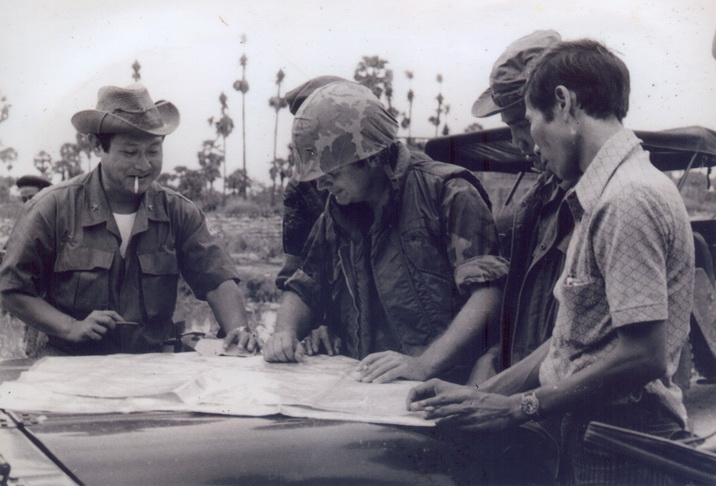
- During his time in Cambodia, Dale accompanied Chantaraingsey on dozens of trips to the field, where he witnessed the bloody battles between republic troops and the communist Khmer Rouge. Chantaraingsey and Dale (centre) consult military charts during one such trip in the early 1970s. (Photo: Courtesy Spencer Dale)
PRINCE Norodom Chantaraingsey was born in Phnom Penh in 1924, a son
of Prince Norodom Chanthalekha, and was from the very first an
iconoclastic figure. In the 1940s, he served in the Japanese-raised
green shirt militia that sought to oust the French, later joining the
Khmer Issarak, an anti-colonial movement then based in Thailand. By
1951, Chantaraingsey had established himself in rural Kampong Speu – his
future base of operations – and developed into what historian Ben
Kiernan has described as a “comprador warlord”, maintaining about 500
men under arms.
Many details of Chantaraingsey’s life in this period remain obscure.
Julio A Jeldres, Sihanouk’s official biographer, said royal records show
he was married at some point to Princess Sisowath Samanvoraphong, a
daughter of King Sisowath Monivong. He said that Minh Chin, the woman
claiming to be the Prince’s wife, did not appear in the royal archives.
“It was common for princes and other aristocrats to have mistresses
[that] were not necessarily recognised by the Royal Court and would,
therefore, not appear in the records,” he said.
But Jeldres said there were many examples of Cambodians falsely
claiming to be royals or married to royals, and questioned Minh Chin’s
claim that she was Chantaraingsey’s wife. (He said there was no birth
date recorded for Princess Samanvoraphong, and cited refugee reports
that she died with the prince in the hills of Battambang, where they had
been hiding and leading an unsuccessful struggle against the Khmer
Rouge).
But Prince Sisowath Thomico, an adviser to King Norodom Sihamoni,
said he “would not be surprised” if the secretive Chantaraingsey had
taken a second wife.
“He always behaved as a warrior, which he really was, and would stay
apart from the rest of the Royal Family,” he said. “Few people really
knew him.” Thomico said polygamy was once common in Cambodia, both for
royals and commoners, and was not expressly outlawed until the passage
of the 1976 Khmer Rouge Constitution. Dale added that Minh Chin – who he
knew as Madame Chantaraingsey – “was the only one I ever saw” in the
prince’s company, providing photos of the two together at a dinner party
in the early 1970s.
Minh Chin – born into a middle-class family in Kampong Speu in 1933 –
claims she was married to Chantaraingsey at just 15 years of age, after
he arrived in her village to distribute Issarak propaganda. She said
she resisted his advances at first, assuming he was already married –
something he later denied. In the early 1950s, she spent a lot of time
in the field with Issarak units, learning to handle firearms and ride
horses. After the country gained its independence from France in
November 1953, Chantaraingsey rallied to the side of then-King Sihanouk,
and the couple traded the difficulties of life in the maquis for a more
comfortable life in Phnom Penh.
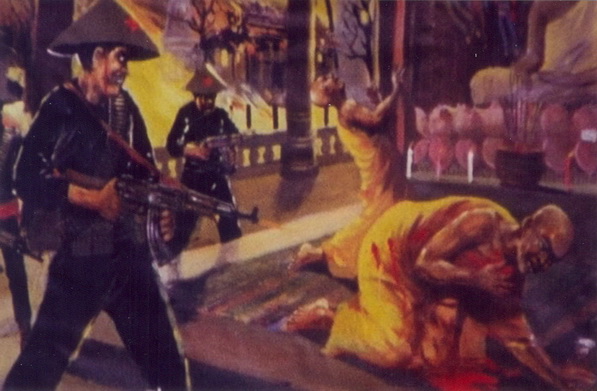
- A snapshot of Lon Nol-era ideology. In a film grab from the 1970s, Dale captured the anti-Vietnamese propaganda that was posted in Phnom Penh during the Khmer Republic. (Photo: Courtesy Spencer Dale)
CHANTARAINGSEY shared the baby-faced looks and good-natured grin of
his cousin Sihanouk, as well as his iconoclastic nature, but the
relationship between the two ran hot and cold. In 1957, after his return
from a military academy in France, Chantaraingsey was accused of
disloyalty and jailed on lèse majesté charges. After a year in
prison – a time in which he reportedly penned a series of romantic poems
– he was released and slowly rehabilitated by Sihanouk’s government. He
was eventually appointed director of the Phnom Penh Casino and went on
to amass a large personal fortune.
When Sihanouk was overthrown by Lon Nol in March 1970, Minh Chin
said, Chantaraingsey was asked to raise a brigade to fight the
communists and eagerly rose to the challenge, displaying a degree of
competency that bucked the trend in the graft-ridden Khmer Republic. As
he went about assembling the 13th Brigade, based in Kampong Speu, many
of the troops were drawn from the families of the Issarak rebels he led
in the early 1950s. The uniforms of his men bore a roaring tiger
insignia in honour of Chantaraingsey’s birth year.
Jeldres said US diplomatic reports from 1973 and 1974 paint
Chantaraingsey as one of the “most efficient” officers in the Khmer
Republic, to the extent that Lon Nol – fearing a potential rival –
forced him to renounce his royal title. Under his command, the 13th
Brigade managed, in 1973, to recover the Kirirom plateau, which had been
under communist control since 1970. Jeldres said FANK’s commander in
chief, Sosthene Fernandez, trusted him so much that put him in sole
charge, in early September 1974, of dealing with Khmer Rouge leaders
thought to be open to negotiation.
In April 1973, the New York Times reported that
Chantaraingsey was a “virtually independent warlord”, straddling
National Road 4 in Kampong Speu. As the head of Brigade 13, he
reportedly controlled a 200-square mile “fief” encompassing 60 villages
and an estimated 100,000 people. Times journalist Sydney
Schanberg described tours arranged by Chantaraingsey for foreign
officials and journalists as “models of public-relations expertise”,
often capped off by boozy lunches in the field.
It was undoubtedly on one such occasion that Chantaraingsey first met
journalist and poet James Fenton. Fenton later immortalised the prince
in his poem ‘Dead Soldiers’, the title of which was a sardonic reference
to the empty brandy bottles that amassed during a battlefield banquet:
They lived well, the mad Norodoms, they had style.
The brandy and the soda arrived in crates.
Bricks of ice, tied around with raffia,
Dripped from the orderlies’ handlebars
The brandy and the soda arrived in crates.
Bricks of ice, tied around with raffia,
Dripped from the orderlies’ handlebars
For Fenton, Chantaraingsey – a Norodom battling his cousin, Sihanouk –
embodied the familial nature of the civil war, which eventually
consumed most of the princes and revolutionaries that made up its cast.
(Saloth Chhay, Pol Pot’s elder brother, at that time served as an
orderly to Chantaraingsey, further confusing the war’s tangled web of
familial relations).
As the noose tightened on the Khmer Republic, and as Chantaraingsey
came under pressure from the regime’s powerbrokers, the Prince
reportedly used his own fortune to purchase American weapons from other
Cambodian generals.
“He sold everything he had in the end,” Dale said. “He got bucket
loads of cash, and went around to the Cambodian commanders and bought
weapons and ammunition from them, so his men would have the best
equipment. That’s the sort of man he was.”
AS Dale spent more time with Chantaraingsey facing the rigours of
combat, the line between observation and personal involvement began to
blur. After seeing the horrors of the war up close – the “innocent
people being blown apart” – he drew closer to Chantaraingsey’s men,
resolving to help them any way he could. He also started arming himself
before patrols, ready to defend himself if the situation turned sour.
Miraculously, Dale avoided any serious injury, only sustaining two minor
wounds from M79 grenade shrapnel.
In late 1971, Dale’s involvement in the Cambodian war caught the
attention of the US government, and he soon started passing information
to the Central Intelligence Agency. Regular briefings took place in
Honolulu, he said, and the CIA’s agents were hungry for any information
about the Khmer Republic’s cloak-and-dagger intrigues.
The US connection inevitably led Dale into more involved intrigues of
his own. In August 1973, with tacit approval from then-deputy US air
force attaché Robert Krim, Dale claims he had a midnight meeting with
Chantaraingsey to discuss getting rid of the ailing Lon Nol in a
bloodless coup. The Prince pulled up in his Citroen outside his late
father’s villa on Suramarit Boulevard, Dale recalled; orderlies handed
out ice-cold, cologne-scented towels. The plan, he said, would have
allowed Sihanouk to return from his exile in Beijing, where he was
acting as titular head of the communist resistance, but would have
barred him from taking any active part in politics. Chantaraingsey was
also confident several Khmer Rouge commanders in Kampong Speu were
willing to “come across” to the government for a sweetener of between
US$5 million and $10 million each.
“We wanted to change the whole direction of the war, and it was the
only way we could stop the slaughter,” Dale said. “And if the US had
seen fit to do it and seen the light, this whole bloody mess could have
been avoided. We’ll never know, but there was a hell of a chance.”
In the end, the US Embassy in Phnom Penh rejected the coup plan; Dale
said they were afraid they wouldn’t be able to keep the increasingly
popular Chantaraingsey on a short leash. (Dien Del, another brigadier
general during the Lon Nol regime, confirmed Chantaraingsey had aired
secret plans to overthrow Lon Nol, though the plot was quashed before
any specifics reached him).
Four weeks before the fall, as the ailing republic entered its death
throes, Dale took one of the last commercial flights out of the country.
Through his connection with the CIA, he said he tried to procure more
covert support for Chantaraingsey, one of the few men he thought capable
of reversing the regime’s slide into the abyss.
“I pushed for everything they could get to him,” Dale said. “I
arranged to see him again just before the end, but when things collapsed
they collapsed very quickly and I couldn’t get back there.” “It was
probably for the best,” he added, “because if I had have got up there, I
wouldn’t have got back.”
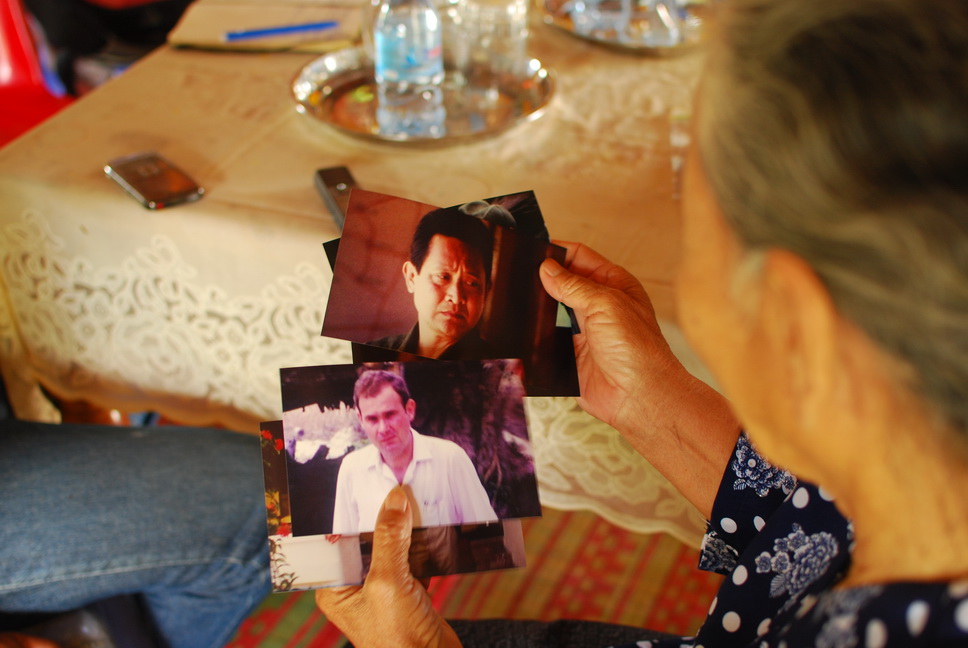
- Minh Chin, who claims she was married to Prince Chantaraingsey from the early 1950s – when he was an anti-colonial rebel leader – until the fall of Phnom Penh to the Khmer Rouge in April 1975. “I don’t know how he died, where he died, or when he died.” she said. (Photo: Sebastian Strangio)
ON April 17, 1975, Minh Chin joined the mass exodus out of Phnom
Penh, and boarded a boat bound for Battambang. Earlier that morning, she
said, she had sent her adopted son to school; a few hours later, after
black-clad Khmer Rouge cadres had fanned out across the city, she was
barred from entering the school building. She never saw him again.
En route to Battambang, the cadres in charge of the boat killed
several of the passengers, and she recalled spending the trip trying to
erase her old identity as a general’s wife and socialite. She readopted
her maiden name and passed the Khmer Rouge years on a collective farm in
Kampong Speu’s Phnom Sruoch district. She survived, like many others,
by burying her past and severing her ties with the vanished pre-war
world.
“They monitored me every day because they didn’t believe my husband
was a farmer,” Minh Chin said. She said she even pretended to fear
handling guns – a staple of her time with the Issarak – out of fear it
would prompt suspicion.
After the fall of the regime in early 1979, Minh Chin spent a year in
Siem Reap before returning to Kampong Speu to try to track down her
husband and relatives. “I didn’t see any of my relatives,” she said. “My
neighbour said all of my family and my mother were killed by Pol Pot
soldiers.”
After the fall, Dale says he tried to channel additional arms to
Chantaraingsey through his intelligence contacts, in the hope he would
reach the Thai border and establish a base of resistance there. Due to
the 1970 Cooper-Church Amendment, which barred US military assistance to
Cambodia and Laos, all procurements had to be undertaken covertly, and
were to be funneled to the border with the aid of Thai military
intelligence. Before the fall, a shipment of tens of thousands of
inexpensive Sten submachine guns arrived from Europe, but the attempts
came to naught when Chantaraingsey failed to resurface.
“We thought he would be able to bring many thousands of people,” he
said. “It was all pretty hopeless … No one made it from the 13th
Brigade.”
DALE claims that according to research he has conducted over the past
year, which involved interviews with former Khmer Rouge and FANK
officers, Chantaraingsey was on the outskirts of Phnom Penh at the time
of the Khmer Republic’s surrender. Due to the speed of the fall,
Chantaraingsey’s original plan – to make a final stand at a FANK base at
Doh Kanchor, about 56 kilometres south of Kampong Speu town, in Phnom
Sruoch district – was foiled. The base was unprepared for the Khmer
Rouge assault that hit it shortly after the regime’s surrender. It ran
up the white flag on the first day, forcing Chantaraingsey to attempt an
escape to Thailand.
Citing an eyewitness account given by a former Khmer Rouge soldier
from Pailin, Dale said Chantaraingsey was eventually captured in Kirirom
National Park after his convoy of armoured personnel carriers ran out
of gas. The soldier reported seeing Chantaraingsey – stripped naked
except for a krama around his waist – handed over to men under the
command of Ta Mok, then in charge of the Khmer Rouge’s Southwest Zone.
Dale says the handover took place at an old ammunition factory off
National Road 4, a few kilometres south of the Kirirom plateau. He puts
the date at between April 20 and 22. “He saw Chantaraingsey being led
away with the soldiers … and that’s the last anybody knows.” At some
point afterwards, Chantaraingsey was presumed killed, along with his
remaining men.
Dale summed up Chantaraingsey as a “romantic” figure, whose fatal
indecisions in the final days of the Khmer Republic prevented him from
taking a proud stand with his men at Doh Kanchor. “It just all fell
apart at the end like a house of cards – it just collapsed – and it
shouldn’t have,” Dale said. In the end, the 4,500 inhabitants of the
base – which included soldiers, their wives and their children –
surrendered and were butchered methodically by the Khmer Rouge. Dale
said just 18 survived.
It is impossible to determine Chantaraingsey’s precise fate, since
the key figures who spoke with Dale did not wish to be interviewed for
this article. But Dale says he believes his version of events to be the
“honest-to-God truth”, and after investing thousands of dollars and
countless hours in finding it out, he says he will return to Australia
content, perhaps to write up an account of his years in Cambodia.
“It’s been worth it. Every dollar I’ve given away… has been money
well spent to find and escape from the horror that’s haunted me all
these years,” he said. “The whole thing is just a hell of a story.”
ADDITIONAL REPORTING BY MAY TITTHARA
[Published in the Phnom Penh Post, December 10, 2010]

6 comments:
Chantaraingsey was a Cambodian hero. He was a fighter and not a coward like Sihanouk who is a useless Norodom, not dissimilar to the poofter on the throne now and the many other Norodoms schomeur deluxes living in Paris like Sirivudth.Many of my friends died fighting with the 13th Brigade - one of the best fighting units of FANK. Is it not blood boiling when the good Norodom like Chantaraingsey has never been mentioned as a Khmer hero while a treacheous moronic coward like Sihanouk is remembered as a god king - what a stupid world we live in.
The only wife of Prince NORODOM
CHANTARAINGSEY was PRINCESS SISOWATH
SAMANVORAPHONG, the daughter of king
MONIVONG and his last wife KHUN TAT.
She was the sister of the Princess Sisowath
Monikessan (the fourth wife of KIng SIHANOUK) and
the Prince Sisowath Chivan Monirak (the former Vice
President of the Senate and former husband of the
princess Norodom Bopha Devi (king Sihanouk
daughter).
Go to the link below King Sisowath Monivong genealogy
http://members.iinet.net.au/~royalty/states/asia/cambodia5.html
Preah Ang Mechas Sisowath Samanvoraphong (by Yinn Tath), married Neak Ang Mechas Norodom Chantaraingsey, born 1924 in Phnom Penh, (son of Preah Ang Mechas Norodom Chanthalekha), died 1975.
One of my friends who was a friend of princess Samanvoraphong family said that Norodom Chantarainsey was a womanizer, and princess Somanvoraphong was a beautiful and devoted wife. That didn't prevent him from having other concubines. They had no children.
When I was reading this article,my tears just dropped like mad. it reminded me to the era, to all the people,whom I knew and served their country.
I pray for those,who had scarified their lives for our country from the communist Hanoi.They were right,but the war was abandoned unexpectedly by American in 1975 and they were trapped by Hanoi and its allied Khmer Rouge's campaign.Very few survived under the communist.
Price Chantaraingsey and prince Serim matak were both Khmer heroes. They fought to their last blood.
Heroism will never die,we will glamorize it when the time come.
The fight must go on to free our nation from Hanoi.We are from the warrior blood race.See Angkor Wat's bas-relief. You will see our warrior ancestors run into the battle field,without any fear although their comrades fell in front of them.
Some live their lives like plastic bags,some live their like gold.
True Khmer
A more positive story is now emerging from the gloomy terror filled years of the Cambodian civil war. A documentary is now in production about General Prince Norodom Chantaraingsey and an Australian QANTAS flight attendant whose life he saved in 1971 when targeted by the Khmer Rouge. "Dale of Cambodia" is the true story of the unusual friendship between the Australian, Spencer Dale and the Chantaraingsey. It's a story of commitment, loyalty and friendship towards a man and a country facing complete inhalation from Pol Pot's Khmer Rouge. We need to be uplifted by some good things that happened and be inspired to make a positive change in a world that doesn't seem to learn from its mistakes. It's good to know there are still people who care and are prepared to make a difference.
Previews can be seen at www.daleofcambodia.com and www.facebook.com/daleofcambodia
From what I heard, Gen. Norodom Chanransey didn't died in 1975. He vanished. Here is image growing old.
http://www.youtube.com/watch?v=thOd2M87lGo
Post a Comment